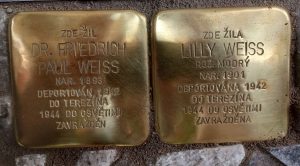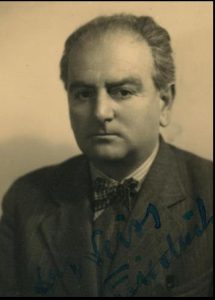 Umístění: PAŘÍŽSKÁ 66/13, PRAHA 1
Umístění: PAŘÍŽSKÁ 66/13, PRAHA 1
Narozen 04. 04. 1893
Poslední bydliště před deportací: Praha V., Pařížská 13
Adresa/místo registrace v Protektorátu: Praha V, Norimberská 14
Transport Cc, č. 426 (20. 11. 1942, Praha -> Terezín)
Transport Em, č. 455 (01. 10. 1944, Terezín -> Osvětim)
Zavražděn
Three lives of millions were senselessly and criminally wiped out. One more thing should not be forgotten: in the GENI.com website of the family trees of Friedrich and Lilly Weiss, other Holocaust victims can be found: 10 relatives of
Friedrich, including his mother, 13 relatives of Lilly, including her mother, as well as her aunt, cousin and husband and daughter named “Kauders”, these are the relatives with whom the Weiss family found accommodation in Prague at Pařížská 13/66. STOLPERSTEINE are also being laid for Hermine Modr˝ Grimm and Olga Kauders, Lilly’s mother and aunt, in front of the house at Pařížská 13/66, their proven last place of residence before their deportation and murder.
Dr. Rolf Rˆschke ([email protected]), Erkner near Berlin, grandson of Gudrun and Friedrich Weiss from Erkner, in April 2024.
t was also inconceivable that Austria would suddenly become part of the National Socialist
Greater German Reich. But that is exactly what happened in March 1938. And just six
months later, the entire Austrian bureaucracy had been brought onto the Nazi course and
Friedrich, like all Jewish doctors, was banned from practicing his profession.
The only way out they saw was to move to Czechoslovakia, because Lilly was Czech. They
found shelter in this house, namely with Lilly’s relatives, the Kauders family. At first they
could breathe a sigh of relief, but just a few months later, on March 15, 1939, National
Socialism caught up with them in Prague with the occupation of Czechoslovakia.
A nerve-racking battle with the Czech bureaucracy, which was gradually being brought onto
a Nazi course too, began. Every three months they had to extend their residence permit for
Prague, while at the same time they submitted various applications for a visa. Ireland, the
USA and Shanghai are recorded as their destinations of emigration. Despite provisional
passports in 1939 and the certificate that there was no criminal offense against them, they
could not leave the country.
This nerve-racking battle to leave the country lasted for over two years. How did they get
through it without work, or did they find odd jobs, did they support their relatives, were they
able to live off their savings? Their daughter Susanne was now 11 years old. What a
childhood! Was she able to go to school? We don’t know any of that.
And then suddenly they received identity documents after all. Although the names Israel and
Sara were now added to their first names, the usual stigmatization of Jews, the main thing
was identity papers! The longed-for opportunity to leave now seemed within reach, and
previous despair gave way to euphoric hope. So many of their relatives had made it, such as
Lilly’s cousin Stephen Mory, who managed to leave for England in 1939 and later for
Australia. I have been corresponding with one of his daughters, Louise Mory, born in 1954,
since my research, and this is how she and her four siblings and their children first learned
about the fate of their relatives in faraway Europe, because their father, Lilly’s cousin
Stephen Mory, had never spoken about it.
But back to our Weiss family. They only hoped to be able to leave the country, it was a flash
in the pan of hope. 1½ years later – certainly a time of deep depression and despair because
of the unsuccessful exit – on November 20, 1942, they were deported to Terezin.
Two years in a concentration camp followed, where daughter Susanne spent her 13th and
14th years. In any case, the family seems to have been together – a small consolation. Who
knows what self-doubt and self-reproach gnawed at them, especially with regard to their
daughter, who still had her whole life ahead of her. “If only we had decided differently back
then, we would have emigrated from Vienna straight away and not gone to Prague…” they
may have asked themselves.
I spent two days in Terezin last year, a beautiful but sad city, but at the time it was the
antechamber to hell. Only daughter Susanne has a sign of her stay in Terezin, namely her
signature and date of birth on one of the plaques with about ten thousand murdered
children in the Terezin Ghetto Museum:
WEISSOVÁ ZUZANA 26.7.1930.
And then the long-feared thing happened. The family was torn apart and Friedrich was
transported to Auschwitz on October 1, 1944, followed by Lilly and Susanne three days later
on October 4, 1944.
